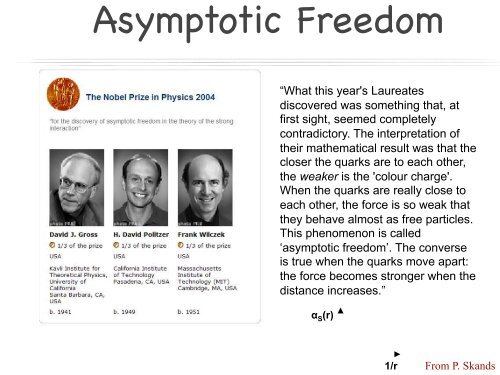Introduction to QCD slides - P.Hoyer.pdf - High Energy Physics Group
Introduction to QCD slides - P.Hoyer.pdf - High Energy Physics Group
Introduction to QCD slides - P.Hoyer.pdf - High Energy Physics Group
Create successful ePaper yourself
Turn your PDF publications into a flip-book with our unique Google optimized e-Paper software.
Paul <strong>Hoyer</strong> Mugla 2010<br />
Asymp<strong>to</strong>tic Freedom<br />
Asymp<strong>to</strong>tic Freedom<br />
“What this year's Laureates<br />
discovered was something that, at<br />
first sight, seemed completely<br />
contradic<strong>to</strong>ry. The interpretation of<br />
their mathematical result was that the<br />
closer the quarks are <strong>to</strong> each other,<br />
the weaker is the 'colour charge'.<br />
When the quarks are really close <strong>to</strong><br />
each other, the force is so weak that<br />
they behave almost as free particles.<br />
This phenomenon is called<br />
‘asymp<strong>to</strong>tic freedom’. The converse<br />
is true when the quarks move apart:<br />
the force becomes stronger when the<br />
distance increases.”<br />
! S(r)<br />
1/r<br />
22<br />
From P. Skands


